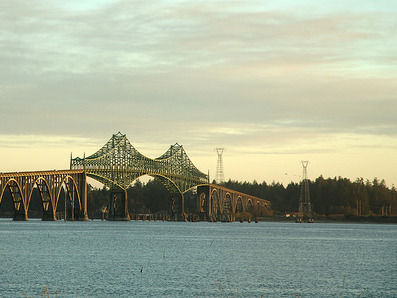New approach improves ability to predict metals' reactions with water
Advertisement
The wide reach of corrosion, a multitrillion-dollar global problem, may someday be narrowed considerably thanks to a new, better approach to predict how metals react with water.

Corrosion is a multitrillion-dollar problem affecting a wide range of machinery and structures worldwide. Pictured here is the Coos Bay Bridge in Coos Bay, Ore.
OSU photo by Lynn Ketchum
Researchers at Oregon State University and the University of California, Berkeley, have developed a new computational method that combines two techniques to make predictions faster, less costly and more effective.
The findings could have a wide range of applications, including in the design of bridges and aircraft engines, both of which are susceptible to corrosion.
Every metal except precious metals like gold and silver reacts with water, said Doug Keszler, distinguished professor of chemistry in Oregon State's College of Science.
"We'd like to predict the specific reactions of metals and combinations of metals with water and what the products of those reactions are, by computational methods first as opposed to determining them experimentally," said Keszler, who also serves as director of the Center for Sustainable Materials Chemistry at OSU.
Traditionally, Keszler noted, when looking at metals dissolved in water, the chemical assumption has been that a metal dissolves to form a simple salt. That's not always what happens, however.
"In many cases, it initially dissolves to form a complex cluster that contains many metal atoms," he said. "We can now predict the types of clusters that exist in solution, therefore furthering the understanding of metal dissolution from a computational point of view."
Studying aqueous metal oxide and hydroxide clusters from Group 13 elements - aluminum, gallium, indium and thallium - scientists coupled quantum mechanical calculations with a "group additivity" approach to create Pourbaix diagrams, the gold standard for describing dissolved metal species in water.
"Applying this new approach, we arrive at a quantitative evaluation of cluster stability as a function of pH and concentration," said study co-author Paul Ha-Yeon Cheong, associate professor of chemistry at OSU.
Understanding clusters is critical because of the role they play in chemical processes ranging from biomineralization to solution-deposition of thin films for electronics applications. And characterizing corrosion stems from being able to depict metals' stable phases in water.
"If you're designing a new steel for a bridge, for example, you'd like to include the potential for corrosion in a computational design process," Keszler said. "Or if you have a new metal for an aircraft engine, you'd like to be able to determine if it's going to corrode."
These examples are not merely hypothetical. Just last summer, a Japanese airline had to refurbish all 100 Rolls-Royce engines on its fleet of Boeing 787 Dreamliners after a series of engine failures caused by the corrosion and cracking of turbine blades. The engines sell for $20 million each.
"Most Pourbaix diagrams do not include these metal clusters and hence our understanding of metal dissolution and reaction with water has been lacking," said study co-author Kristin A. Persson, professor of materials science at UC Berkeley. "We have now uncovered a fast and accurate formalism for simulating these clusters in the computer, which will transform our abilities to predict how metals react in water."




























































